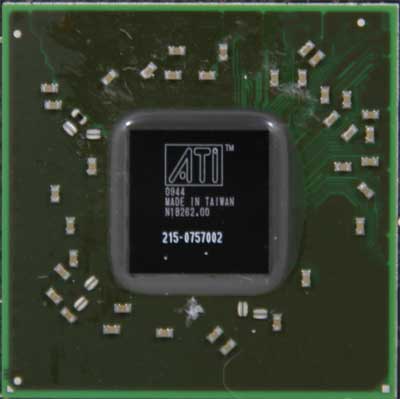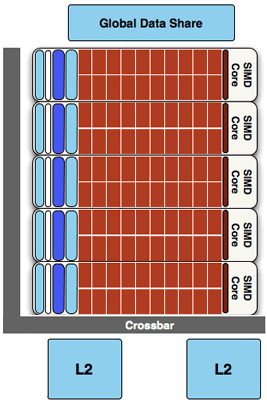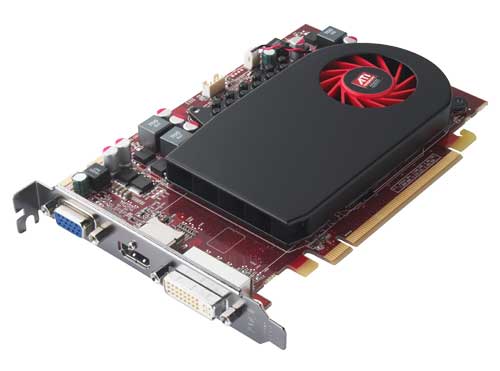AMD's Radeon HD 5670: Sub-$100 DirectX 11 Starts Today
by Ryan Smith on January 14, 2010 12:00 AM EST- Posted in
- GPUs
After a holiday break, AMD’s staggered launch of the Evergreen family picks back up today with the launch of the Radeon HD 5670. The 5670 marks the desktop launch of Redwood, the 3rd chip in the Evergreen family, designed to fit in below the Juniper chip that powers the Radeon HD 5700 series.
| ATI Radeon HD 5750 | ATI Radeon HD 4850 | ATI Radeon HD 4770 | ATI Radeon HD 5670 | ATI Radeon HD 4670 | |
| Stream Processors | 720 | 800 | 640 | 400 | 320 |
| Texture Units | 36 | 40 | 32 | 20 | 32 |
| ROPs | 16 | 16 | 16 | 8 | 8 |
| Core Clock | 700MHz | 625MHz | 750MHz | 775MHz | 750MHz |
| Memory Clock | 1.15GHz (4.6GHz data rate) GDDR5 | 993MHz (1986MHz data rate) GDDR3 | 800MHz (3200MHz data rate) GDDR5 | 1000MHz (4000MHz data rate) GDDR5 | 1000MHz (2000MHz data rate) GDDR3 |
| Memory Bus Width | 128-bit | 256-bit | 128-bit | 128-bit | 128-bit |
| Frame Buffer | 1GB / 512MB | 1GB / 512MB | 512MB | 1GB / 512MB | 1GB / 512MB |
| Transistor Count | 1.04B | 956M | 826M | 627M | 514M |
| TDP | 86W | 110W | 80W | 61W | 59W |
| Manufacturing Process | TSMC 40nm | TSMC 55nm | TSMC 40nm | TSMC 40nm | TSMC 55nm |
| Price Point | $129 - $149 | $99-$129 | $129 | $99 / $119 | $60-$90 |
AMD has been relatively straightforward in designing the Evergreen family. Each chip is half of its bigger brother. This means that the Redwood chip and the 5670 is in most ways half of a Juniper/5770: half the SIMDs (400), half the ROPs (8), half the texture units (20), etc. The core clocks are also slightly changed compared to the 5870 and 5770; here we have a core clock of 775MHz instead of 850MHz as found on those cards. So on paper, the 5670 is going to be slightly less than half of a 5770 in performance.
The one hardware unit that hasn’t been halved is the memory bus – we still have the same 128-bit GDDR5 memory bus as found on the 5770, but here it’s clocked at a 4GHz data rate. So the 5670 has a higher bandwidth-to-compute ratio than the 5770 does.


In nearly chopping Juniper in half, AMD has brought the transistor count down from 1.04B to 627M. Those transistors occupy a space of 104mm2, which is understandably smaller than the 5770, but also smaller than the RV730 GPU that powers the Radeon HD 4670, the card the 5670 replaces. This smaller die brings load power down to 61W, and idle power down to 14W.
While most of the functional units have been halved, the feature set remains otherwise unchanged from the rest of the 5000 series. DirectX 11, UVD2 video decoding, angle-independent anisotropic filtering, HDMI bitstreaming, and supersample anti-aliasing are all accounted for. Eyefinity is also here, using a slightly different port configuration to continue bringing support for 3 monitor Eyefinity.

At $99, the 5670 is intended to stake out the all-important sub-$100 position for video cards, which is a big price point for price-sensitive buyers and OEMs. Bear in mind that the entire sub-$100 market encompassed 2/3rds of all video card sales last quarter, according to AMD and Mercury Research. Given the low transistor count and small die size of the 5670, we expect that AMD will have a lot of price latitude to work with going forward – as 40nm production costs and GDDR5 costs come down, this board should be cheaper to make than the 4670 ever was.
AMD considers the chief competition for this board to be the NVIDIA GeForce GT 240, which we reviewed last week. However this price point also brings AMD into competition with last year’s parts: the GeForce 9800 GT and Radeon 4850. The former is in good supply, and the latter still available enough at this moment to be a viable alternative. As we’ll see, this is by no means a slam-dunk for AMD today.
Coming from CES, we had a chance to talk to vendors about the 40nm TSMC situation, which has been a thorn in AMD’s side since the launch of the 4770 last year. What we’re hearing is that the situation is improving (which is why 5800 series cards are finally usually in stock) but that it’s still not as good as everyone would like. For this launch there are 50k+ cards, which should be more than enough to satisfy demand. We don’t expect there to be any supply issues with the 5670.










73 Comments
View All Comments
Slaimus - Thursday, January 14, 2010 - link
Another nice thing about it is that it makes an inexpensive triple-head card that does not need external power, even if one of the heads needs to be Displayport. Even a single link HDMI/DVI can still support 1920x1200.SlyNine - Thursday, January 14, 2010 - link
Is the 4670 you have in your comparison charts a 4670 with DDR3 or DDR2?Also any news on the mobile version of this card or the 5380 I've seen in alot of notbooks?
Ryan Smith - Thursday, January 14, 2010 - link
GDDR3.And I don't have any news on the mobile 5000 series. Nor is there a 5830 that I have been informed of.
Blahman - Thursday, January 14, 2010 - link
5830 is in the HP Envy 15.Ryan Smith - Thursday, January 14, 2010 - link
If it's in a laptop, then it's going to be a neutered Juniper. The Mobility series is always a part down, so a Mobility 5800 series part would be Juniper based.SlyNine - Thursday, January 14, 2010 - link
I'm sure I seen it in 2, including the Envy15, Perhaps I shouldn't have said "alot".But it would be good to have a review comparing the mobile solutions out there. Not to mention the throttling problems in some notebooks.
I'd love to see Anandtech do a review of the problems the Dell XPS 16 w/ Core I7 has. On A/C and only on A/C it cuts the multiplier to 7 and then uses a clock modulation. Clock modulation tells the cpu to only do work certain cycles, so you can have as many as 75% of your CPU cycles going to waste.
The end result is a Dell 1645 Core I7 running at the equivalent of 300mhz.
more info at this forum : http://forum.notebookreview.com/showthread.php?t=4...">http://forum.notebookreview.com/showthread.php?t=4...
Full story here, and just for the record, Id be willing to let Anandtech borrow my 1645 to test if Dell doesn't fix it with this next BIOS update, which I don't see how they can 90watt AC is simply not enough.
WT - Thursday, January 14, 2010 - link
I read through that thread yesterday. We support 50+ Dell e6500 laptops that have been problematic in other ways besides throttling, but it was nevertheless interesting to read and pass along to my fellow IT co-workers.JarredWalton - Thursday, January 14, 2010 - link
I've looked at the thread and sent Dell an email asking for comment. It's important to remember power supply (power brick in this case) efficiency, so if the brick can output 90W and it's only 75% efficient (which is probably higher than what it really achieves), power draw at the wall of up to 120W might be achievable without the need to throttle. So, it's possible that a BIOS update will indeed address the problem, but let's not jump to any conclusions just yet....I'd also say that if you're using FurMark to achieve the throttling, find something else instead. FurMark really pushes the envelope and many consider it a power virus. I understand others are saying it occurs with regular games, which is obviously a much bigger issue than with a test program that doesn't represent a real-world workload.
Anyway, if you really want to send us the laptop for testing, why not do the testing yourself and use that as the basis for an audition to AnandTech? If you go that route, I would make sure you really investigate when throttling does and doesn't occur, look at the various power profiles and try tweaking those, etc.
As a side note: with Win7 I noticed on at least one laptop that using the "passive" cooling profile caused video playback to stutter, and setting it to "active" fixed the problem. There are so many variables that you can never know 100% what might be causing a particular problem.
SlyNine - Sunday, January 17, 2010 - link
Jarred thanks, I'm going to take you up on that and currently I'm doing a write up on the XPS 1645 w/ RGB. I would love any suggestions or if you would like me to include anything please send them to SlyNine@hotmail.com with the subject: XPS 1645. If anyone knows any tools other then throttle stop to monitor the CPU modulation that would also be helpful.SlyNine - Thursday, January 14, 2010 - link
Yea I don't use FurMark at all, in fact I made a post recommending them not use it.With just UT3 nothing else going on the multiplier hits as low as 7 and with the brightness up halfway the modulation kicks in bringing the CPU down to 25%, that's only 25 cycles out of every 100 that's willing to do anything. Even just doing a Prime 95 run the multi is below 10, correct me if I'm wrong but isn't it supposed to be around 13?
But thanks a TON Jarred for acknowledging this, If a high profile sit like Anandtech did a story on it I'd imagen that dell would have to respond. Really this is an Amazing laptop otherwise (other then this line I have threw my screen but obviously that is covered by warranty.)